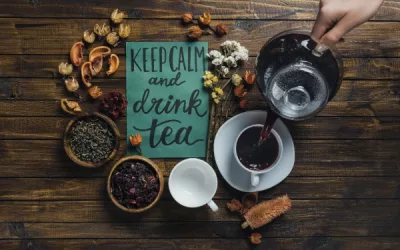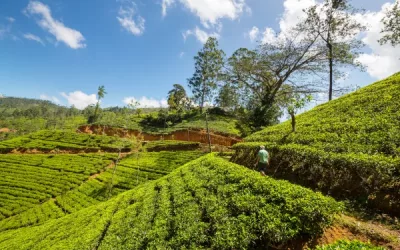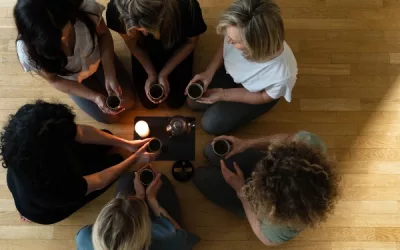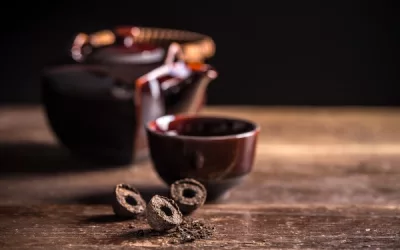Ever wondered why a simple cup of tea and a scone can be so significant in English culture? Cream tea, steeped in history and tradition, is more than just a delightful treat; it embodies the essence of social gatherings across England, particularly in Devon and Cornwall. This guide will unravel the nuances of cream tea, from its roots to modern variations, and offer tips on how to host your own perfect tea event. Dive in and discover why this beloved ritual deserves a place in every food lover’s heart!
Table of Content
- What is cream tea?
- How to prepare a traditional cream tea?
- What are the differences between Devon and Cornish cream tea?
- What is the cultural significance of cream tea?
- What are some popular variations of cream tea?
- How can one host a perfect cream tea event?
- What are the health benefits and considerations of cream tea?
- What resources are available for learning more about cream tea?
- Conclusion
What is cream tea?
A cream tea is a quintessential British tradition that combines two beloved elements: tea and scones. This charming custom features a pot of freshly brewed tea, accompanied by scones, clotted cream, and jam. Typically enjoyed in the afternoon, cream tea offers a delightful break from the day. The scones are hearty, with a slightly crumbly texture. The clotted cream, originating from the rich pastures of Devon and Cornwall, is luxuriously thick and spreadable, while the jam, often strawberry or raspberry, adds a sweet balance.
The origins of cream tea are rooted deeply in the history of Devon and Cornwall. Legend has it that the tradition dates back to the 11th century at Tavistock Abbey in Devon. The monks served bread with cream and jam to workers who were restoring the abbey after a Viking raid. Over time, scones replaced bread, and the practice of enjoying these treats with tea became widespread.
What are the key components of a traditional cream tea?
A traditional cream tea has several essential elements:
- Freshly brewed tea: Usually black tea, such as Assam or Earl Grey, served in a pot.
- Scones: Light and slightly crumbly, often plain or occasionally dotted with sultanas.
- Clotted cream: Thick, rich cream with a crusty top, produced by heating unpasteurised cream.
- Jam: Typically strawberry or raspberry, adding a sweet contrast to the cream.
These components come together to create an indulgent and satisfying treat. The ritual of spreading cream and jam on scones and sipping tea embodies a comforting, social experience.
Where did cream tea originate?
Cream tea has a rich history within specific regions of England:
- Devon: Tavistock Abbey is credited with popularising the tradition.
- Cornwall: Known for its own unique take on cream tea, often reversing the order of cream and jam.
In both regions, the pastures’ rich milk led to the distinctive clotted cream. This historical tradition evolved into a beloved routine, celebrated at local tearooms and homes alike. Tavistock Abbey, in particular, played a pivotal role in laying the early foundation for this practice.
What is the significance of cream tea in English culture?
Cream tea holds a special place in English culture, symbolising the country’s love for tea and community:
- Tradition: Cream tea reflects long-standing English traditions and culinary heritage.
- Social Experience: It often serves as a time for relaxation and socialising.
- Tourism: Many visitors to England seek out cream tea for an authentic, cultural experience.
- Festivals: Some regions celebrate with festivals and events, showcasing local produce and traditions.
This custom connects people across generations, fostering communal ties and preserving a piece of cultural history. It represents a pause from the hustle and bustle, offering a moment to savour and connect.
During King Charles II’s reign in the 17th century, cream tea took on a more refined form. The King’s court captivated by the elegance and simplicity of the cream tea, began to endorse it. This royal endorsement helped spread the custom throughout England, turning it into a beloved nationwide tradition. The tradition flourished, making cream tea a staple of English afternoon tea culture.
How to prepare a traditional cream tea?
A traditional cream tea is a delightful British treat that pairs perfect with a leisurely afternoon. In essence, cream tea involves enjoying scones adorned with clotted cream and jam, accompanied by a hot cup of tea. It’s a simple yet indulgent meal that evokes comfort and tradition. Follow this guide to prepare your own delightful experience.
The table below lists the essential ingredients, detailed preparation steps, and practical serving tips. This will help you achieve an authentic cream tea from the comfort of your own kitchen.
| Ingredients | Preparation Steps | Serving Tips |
|---|---|---|
| 1. Self-raising flour | 1. Preheat your oven to 220°C (200°C fan) | 1. Warm the scones slightly before serving |
| 2. Clotted cream | 2. Rub in butter till the mixture appears like breadcrumbs | 2. Serve clotted cream with a small spoon for easy spreading |
| 3. Strawberry jam | 3. Mix in sugar and egg, add milk to form a dough | 3. Provide jam in a small dish rather than the jar |
| 4. Unsalted butter | 4. Roll out the dough and cut into rounds | 4. Scones taste best when freshly baked |
| 5. Caster sugar | 5. Place rounds on a baking tray, glaze with milk | 5. Serve with a pot of fresh leaf tea |
| 6. Egg | 6. Bake for 12-15 minutes till golden brown | 6. Use heated water to brew the tea |
| 7. Milk | 7. Let scones cool before slicing | 7. Pour tea before adding milk |
Begin by gathering all the ingredients you will need: self-raising flour, clotted cream, strawberry jam, unsalted butter, caster sugar, an egg, and milk. Once the ingredients are ready, follow the steps to prepare the scones, ensuring to pay attention to details for the best results. The serving tips will enhance the overall experience, allowing you to present the cream tea in a traditionally appealing manner.
What are the traditional ingredients?
The ingredients for a traditional cream tea are simple, yet each component plays a crucial role in delivering an authentic experience. Here’s a closer look:
- Self-Raising Flour: This is the foundation of the scone, providing structure and texture.
- Clotted Cream: Made by heating full cream slowly, clotted cream is thick and rich, typical of the Devon and Cornwall regions.
- Strawberry Jam: The sweetness balances the richness of the cream, traditionally made with fresh strawberries.
- Unsalted Butter: Adds flavour and moisture, aiding in the creation of a tender crumb.
- Caster Sugar: A fine sugar that incorporates well into the dough.
- Egg: Helps bind the ingredients and contributes to a golden colour.
- Milk: Hydrates and unites the dough, adding moisture.
Here’s a concise bullet point list for quick reference:
- Self-Raising Flour
- Clotted Cream
- Strawberry Jam
- Unsalted Butter
- Caster Sugar
- Egg
- Milk
By using these ingredients, each with its traditional roots, you’ll be sure to craft a cream tea experience that honours its history.
Why is it considered a cultural heritage?
Cream tea is more than just a meal; it’s embedded in the cultural tapestry of England, particularly in Devon and Cornwall. Here’s why:
- Historical Significance: Cream tea dates back to the 11th century when monks in Tavistock Abbey, Devon, gave travellers bread with clotted cream and jam.
- Regional Pride: There’s a friendly rivalry between Devon and Cornwall over the correct way to cream tea—Devon places its cream first, whereas Cornwall spreads the jam first.
- Social Tradition: Traditionally, cream tea serves as a leisurely meal, encouraging conversation and relaxation.
- Symbol of Hospitality: Offering cream tea is a gesture of hospitality and warmth in English culture.
- Culinary Perfection: The combination of crunchy, soft, creamy, and sweet elements makes it a culinary delight.
Here’s a handy summary with bullet points:
- Historical roots dating back to the 11th century
- Regional pride between Devon and Cornwall
- Social meal encouraging conversation
- Symbol of warmth and hospitality
- Culinary delight with perfect balance
Understanding the cultural heritage behind cream tea enriches the experience, making it more than just a meal, but a connection to history and tradition.
The story of its cultural significance can be traced back to Tavistock Abbey in Devon. Monks in the abbey served bread with clotted cream and strawberry preserves to workers who were restoring the abbey after a Viking raid. This act of hospitality slowly evolved into the now iconic cream tea tradition.
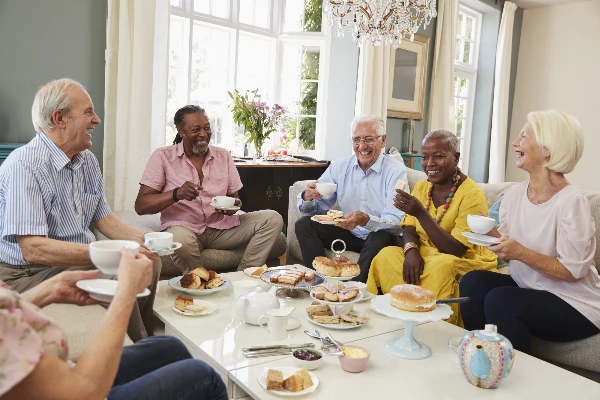
What are the differences between Devon and Cornish cream tea?
When it comes to cream tea, it’s like a culinary civil war between Devon and Cornwall. The main battleground? How one assembles this delicious treat. Buckle up, because this is about to get butter-knife messy.
You start with a scone, which is already its own can of worms (it’s either pronounced ‘scon’ to rhyme with ‘gone’ or ‘scone’ to rhyme with ‘alone’). But the real debate is what goes on top: clotted cream and jam. In Devon, they pile on the cream first, followed by the jam. In Cornwall, it’s jam first and then the cream. So, it’s basically a question of whether you create a creamy base for your sweet topping or a sweet base for your creamy topping.
How is the cream tea served differently in Devon and Cornwall?
In Devon, they like to keep things civilised, putting clotted cream on the scone first. The logic? The thick, rich cream serves as a sturdy foundation for the jam, allowing it to nestle comfortably on the top. Devonshire folk see this as the only reasonable way to layer their goodies, maybe because they think cream deserves pride of place.
In Cornwall, however, they flip the script. Cornish cream tea insists that jam goes first, followed by a dollop of clotted cream. Maybe it’s a rebellious streak, maybe it’s just local pride, but they argue that a layer of succulent jam under a cloud of cream is the real deal.
- Cream first in Devon; jam first in Cornwall.
- In Devon, cream serves as a sturdy base.
- In Cornwall, jam takes the bottom spot.
- Order of layering considered essential to regional pride.
- Serving styles reflect local traditions and preferences.
This cream-before-jam or jam-before-cream debate is not unlike the ludicrous soda vs. pop discourse in America. It’s a trivial thing, yet it keeps the conversation spicy.
What are the unique ingredients used in each style?
Both Devon and Cornwall claim to have the best of the best, down to the very ingredients.
- Devonshire clotted cream: Thick, golden crust.
- Cornish clotted cream: Lighter but rich.
- Devon scones: Fluffy, plump.
- Cornish scones: Slightly crumbly.
- Devon jam: Often strawberry, locally sourced.
- Cornish jam: Same, but sometimes a bit tangier.
Devon’s cream is distinguished by its thicker texture, formed by heating unpasteurised cow’s milk and letting it cool. Cornish clotted cream, might be a tad lighter, but is still impeccably rich. And let’s not forget those scones: Devon’s tend to be a bit fluffier, while Cornish scones carry a slight crumble, which they maintain is the perfect canvas for their method of assembly.
How do these differences reflect regional identities?
You can learn a lot about people by watching how they prepare their cream tea. Think of it as an edible expression of regional identity. Devon and Cornwall aren’t just fighting over culinary preferences; they’re preserving a piece of their history.
- Devon: Cream as the base shows practicality.
- Cornwall: Jam first reflects a hint of rebellion.
- Historical pride: Both regions claim first ownership.
- Tourist attractions: Cream tea is a spotlight for both.
- Cultural heritage: Reflects centuries of local tradition.
In Devon, the preference for cream first symbolises a more down-to-earth, practical approach. It showcases the region’s long-established dairy-farming culture. Meanwhile, Cornwall’s habit of slathering on the jam first signifies a love for fruit preserves historically. Some will say it demonstrates a bit of Cornish creativity and independence.
Interestingly, both counties claim to have invented the cream tea. Some historical references point back to the 11th century monks in Devon, who enjoyed their scones with clotted cream and jam. Cornwall, with its rich maritime history, may have picked up the tradition and added its twist, making it an undeniable part of their cultural heritage.
In the end, no one will likely ever win this debate. You just have to try both and join the argument. Regardless of whether you choose Devon or Cornish, you’re embracing a scrumptiously rich part of British tradition. Sip your tea, tuck into your scone (no matter the order), and take a delicious bite out of history.
What is the cultural significance of cream tea?
If you’ve ever found yourself wandering through the quaint villages of England, you’ve probably encountered the notorious cream tea. This humble yet impressive treat – a heavenly combination of scones, clotted cream, and jam – holds a venerable place in English tradition, but it’s not just about indulgence. Cream tea is an embodiment of English social life, intertwined with cherished customs like afternoon tea and serving as a symbol of warmth and hospitality. Let’s dive into why this delightful practice is more than just a snack.
First off, cream tea finds its roots as a pivotal aspect of afternoon tea, a custom made popular by Anna, the Duchess of Bedford, in the early 19th century. Faced with the torture of hunger between lunch and dinner, she requested tea and a light snack in the late afternoon. Before long, it turned into a sociable ritual among the upper classes. Today, cream tea has morphed into an essential part of socialising, whether you’re catching up with a friend or celebrating special moments.
Taking a closer look, it’s apparent that cream tea’s cultural significance is steeped in history and tradition. It’s often enjoyed during relaxed gatherings in tearooms or cosy kitchens – always with an emphasis on community and sharing.
Cream tea’s not just any tea; it’s a bona fide social experience. Sure, you could shove a scone in your gob while binge-watching Netflix, but where’s the fun in that? Traditionally, it’s all about gathering around, chatting, and savouring each bite in good company.
- Connection and Communication: Cream tea fosters conversation. It’s a pause from the hustle and bustle, a time to bond with family or friends.
- Custom and Ritual: The practice has deep roots in history. It’s part of the English afternoon tea tradition, which is inherently ceremonial.
- Celebration: It’s often brought out during special occasions – birthdays, anniversaries, or simply a catch-up with an old mate.
- Ambience and Atmosphere: Typically enjoyed in charming settings, whether picturesque gardens or snug indoors.
- Hospitality and Warmth: Offering cream tea is akin to laying down a red carpet of cheer and comfort for your guests.
Whether you’re indulging in a fancy tearoom or someone’s cosy parlour, it’s all about the experience and the shared moments.
How has cream tea evolved in modern culture?
Believe it or not, cream tea isn’t just for grandmas and period dramas anymore. It’s experienced quite the glow-up, adapting to contemporary tastes while preserving its old-world charm.
- Variety in Ingredients: From gluten-free options to exotic jams like champagne and strawberries, there’s something for everyone now.
- Global Reach: No longer limited to the English countryside, cream tea has found fans worldwide.
- Alternative Settings: Think quirky cafés and trendy pop-up tea shops, far from your granny’s parlour.
- Modern Twists: Some establishments add gourmet touches – lavender scones, anyone? Or maybe matcha-infused clotted cream.
- Inclusivity: Modern cream tea settings are inclusive, being designed to accommodate different dietary requirements and preferences.
So, while the essence remains the same, cream tea has evolved, allowing it to maintain its relevance in a fast-paced world.
What are some traditional settings for enjoying cream tea?
Call me old-fashioned, but nothing beats indulging in cream tea in a proper setting. Traditional locales radiate a charm and authenticity that heightens the experience.
- Country House Hotels: Nestled in charming settings, offering a slice of history with your scone.
- Seaside Tea Rooms: Particularly in Devon and Cornwall, areas synonymous with cream tea.
- Gardens and Conservatories: Envision sipping tea surrounded by blooming flora.
- Village Cafes: Quaint, sometimes rustic, these are the heart of local culture.
- Historical Landmarks: Properties like stately homes or castles sometimes serve cream tea, adding a touch of grandeur.
These timeless venues offer a retreat from the mundaneness of daily life, transporting you to a slower, more reflective era.
Now, speaking of historical retreats and grand settings, did you know that Sir Winston Churchill, an avid lover of tradition, frequently indulged in cream tea? During World War II, Churchill would often retreat to Chartwell, his home in Kent, to strategise and relax.
Accompanied by his trusted staff, he found solace in the simplicity of a well-prepared scone with clotted cream and jam. It wasn’t merely about the nourishment; it was an act of defiance against wartime hardships, a small luxury that lifted spirits and reminded them of the enduring English way of life.
So, next time you find yourself enjoying cream tea, think of it as not just a treat, but a slice of history that you’re partaking in. Cheers!
What are some popular variations of cream tea?
Let’s dive into the delicious whirlpool of cream tea variations. We’re talking scones that are not just the plain old kind your great aunt Hilda used to make, jams that could send your taste buds on a roller coaster, and creative presentation techniques that might just make you whip out your phone for a quick Instagram snap. Essentially, we’re taking a traditional English cream tea and giving it a modern, quirky twist that would make even the Queen raise an eyebrow, in a good way obviously.
Whether you’re a traditionalist or someone looking for a bit of zing, there’s a cream tea variation out there with your name on it. And if you think gorging on scones with clotted cream and jam is the height of dessert sophistication, thank you Captain Obvious, you haven’t met the rest yet.
What are some unique scone flavours that can be used?
Alright, let’s start with the foundation – the scone. The original scones are great, but why not jazz them up a bit? Here are some quirky flavours you might not have thought of:
- Lemon and Poppy Seed: Adds a zesty kick that pairs beautifully with clotted cream.
- Lavender and Honey: A fusion that feels like a blooming English garden.
- Rose and Pistachio: Floral and nutty; a flavour that transports you to a posh tea party.
- Blueberry and White Chocolate: Sweet with a touch of tartness, almost like a dessert disguised as breakfast.
- Pumpkin Spice: Because why should lattes have all the fun?
Imagine that, a regular scone transforming into something with a personality. Add a touch of pumpkin spice, and voilà, it’s a mini autumn festival on your plate. Boring old scones? Not on your watch!
How do different jams enhance the cream tea experience?
Now, if you think all jams were created equal, you’re in for a delightful surprise. The world of jams is like Willy Wonka’s factory – filled with endless possibilities. Here’s how playing around with jams can elevate your cream tea game:
- Raspberry and Gin Jam: Serve this, and your guests will think you’re a culinary genius.
- Strawberry Basil Jam: Got ‘basic’ strawberries? Upgrade them with a hint of basil.
- Chilli and Raspberry Jam: For an unexpected spicy kick that’s nothing short of a thrill.
- Apricot and Ginger Jam: Tangy and spicy, perfect for adding a bit of warmth to the palate.
- Blackberry and Cardamom Jam: Deep flavours with a touch of the exotic, it’s a match made in culinary heaven.
Imagine slathering a scone with a raspberry gin jam. That subtle hint of botanicals from the gin dances with the sweet berries and just melts in your mouth. Trust us, these aren’t just your grandma’s preserves. Modern jams are all about combining classic tastes with fun new twists.
What are some innovative ways to serve cream tea?
Alright, here’s where you can really flex those creative muscles and impress everyone, including yourself. Cream tea doesn’t have to mean just a plate, scone, and jam. There are some innovative ways to present it:
- Cream Tea in a Jar: Layer your scone, cream, and jam in a mason jar – portable and Instagrammable.
- Scone Kebabs: Skewer mini scones and dip them in various creams and jams.
- Deconstructed Cream Tea: Serve each component separately so everyone can DIY their perfect bite.
- Cream Tea Ice Cream Sundae: Scoop some scone pieces, clotted cream, and jam over vanilla ice cream.
- Tea-infused Scones: Infuse your scone dough with Earl Grey tea for a sophisticated twist.
So, consider whipping out mason jars, layering those ingredients, and swooning over the result. It’s not even just about the taste; it also makes the dining experience something to write home about. Plus, it’s always more fun when food comes with a side of DIY.
Back in the day, Queen Victoria herself used to indulge in afternoon tea, the mother of our modern cream tea, with a spread as extravagant as a five-star brunch buffet in today’s standards. She had no Instagram, but we bet she’d approve of these snazzy modern updates. After all, isn’t tradition all about keeping the best bits alive while adding a new twist? Now, put the kettle on and let’s get those fancy scones going!
How can one host a perfect cream tea event?
Hosting a perfect cream tea event is like orchestrating a delightful symphony of scones, clotted cream, and jam. It’s all about getting the details just right to transport your guests to a quintessentially British experience. From selecting the right teapot to mastering the art of scone serving, here’s how you can nail it.
First, let’s talk about the essential items you need to create this charming setup. Think about your favourite tea party scenes in books or films – that’s the vibe we’re going for.
What are essential items to include in a cream tea setup?
Getting your cream tea essentials in order is the first step to hosting success. It’s like prepping a stage before a show – everything needs to be in place to create that picture-perfect moment. Whether you are throwing a casual get-together or a fancy soiree, here’s your checklist:
- Teapot: Go for a classic porcelain or a charming vintage find.
- Tea cups and saucers: Matching sets make your table look cohesive and elegant.
- Scones: Freshly baked, preferably homemade.
- Clotted cream: Rich and thick, straight from Cornwall if you can get it.
- Jam: Strawberry is a traditional favourite, but raspberry also works wonders.
- Butter knives and spoons: For spreading and serving.
- Tea strainers: Especially if you’re using loose leaf tea.
- Napkins: Linen is classy, but paper can be fun and decorative too.
- Cake stand or platter: To present your scones and other treats in style.
Each item adds to the charm and authenticity of the cream tea experience, creating a setting that feels both special and inviting. It’s these small touches that make a big difference.
How can one incorporate a theme into a cream tea event?
Now that you’ve got your basics down, let’s talk themes. A theme can elevate your cream tea from “nice” to “spectacular”. You can go as classic or as quirky as you like – the key is consistency. Here are a few theme ideas to get you started:
- Victorian Garden Party: Think florals, lace, and vintage touches. Outdoor settings with lots of blooming flowers are perfect.
- Alice in Wonderland: Play with mismatched teacups, whimsical décor, and maybe even a few mad hats.
- Royal British: Union Jacks, fine china, and perhaps some tiaras for fun.
- Literary Afternoon: Each table could be themed around a different classic book, perfect for book club gatherings.
- Seaside Picnic: Nautical elements, blue and white décor, perhaps even a few seashells.
With a theme, the sky’s the limit. Just choose what feels right for you and your guests, and make sure to weave it through your decorations, menu, and even your invitations. A well-thought-out theme ties everything together and creates a memorable experience.
What etiquette should be followed during a cream tea?
You’ve got the essentials and the theme, but let’s not forget about the etiquette. Cream tea might be casual compared to a full afternoon tea, but there are still some unspoken rules to keep in mind.
- Stirring: Stir your tea gently, using a back-and-forth motion rather than a circular one to avoid sloshing.
- Scone etiquette: Split your scone, don’t cut it. Slather it with cream first, then jam – or argue about it; both methods have their proponents!
- Pinkies down: Contrary to popular belief, sticking your pinky out while drinking tea is a no-go.
- No slurping: Sip your tea quietly.
- Teapot tips: Always fill the cups of your guests before your own.
- Napkins: Place your napkin on your lap, not around your neck.
Etiquette adds a layer of sophistication to your gathering, making even the simplest event feel special. It’s all part of the charm.
Back in the day, King Edward VII was quite the fan of cream tea. In fact, during his reign, the popularity of tea parties soared, transforming them into the social events of the season. These gatherings became a place where society’s elite would come together, decked out in their finest attire, to enjoy not just tea but also scintillating conversation and, sometimes, even the occasional scandal. Edward wasn’t just a fan of the tradition; he was practically the poster boy for it. His love for leisurely, informal gatherings helped cement cream tea as a beloved British pastime, one that continues to charm people today.
What are the health benefits and considerations of cream tea?
Ah, cream tea! A quintessentially British delight that’s both indulgent and, let’s be honest, a bit of a calorie bomb. But hey, it’s not just about sinful pleasure. Let’s break down the nutritional benefits, pitfalls, and sneaky ways to keep it on the healthier side.
Nutritional Benefits of Clotted Cream and Scones
Surprise, surprise! Clotted cream and scones are not devoid of benefits:
- Rich in Vitamins: Clotted cream is packed with vitamins A and D, essential for a healthy immune system and skin. You’ll also find a dose of B vitamins in those golden scones.
- Bone Health: Calcium in cream supports strong bones. Couple that with the magnesium and phosphorus in scones, and you’ve got a mini bone-health supplement.
- Energy Boost: Both are high in carbs and fats which provide a quick burst of energy. Ideal when you need to avoid a 3 pm slump.
- Source of Protein: Clotted cream contains a fair amount of protein, aiding muscle repair and growth.
- Mood Enhancer: Let’s face it, eating cream tea is happiness on a plate. The sugary scones obviously raise serotonin levels, making you feel good.
So, while it’s no kale smoothie, cream tea has its own perks.
How Can One Enjoy Cream Tea in a Healthier Way?
You don’t have to bid adieu to cream tea if you’re watching your waistline. Just make a few tweaks:
- Whole Wheat Scones: Switch to whole wheat or even gluten-free flour for a healthier scone. You’ll get more fibre, which is good for digestion.
- Reduced-Fat Cream: Opt for a reduced-fat version of clotted cream if you really want to save on calories.
- Sugar Substitutes: Use natural sweeteners like honey or agave syrup instead of sugar in your scone recipe.
- Smaller Portions: Sometimes less is more. Enjoy smaller scones and use less cream. You still get the flavours without the overload.
- Fruit Compote: Try topping your scones with fresh fruit or a low-sugar fruit compote instead of extra dollops of cream.
These swaps won’t make it a superfood, but they’ll definitely reduce the guilt factor.
Are There Any Dietary Restrictions to Consider?
Indeed! Don’t just dive into a cream tea headfirst; consider these points:
- Lactose Intolerance: Clotted cream is a dairy product, so it’s a no-go for the lactose intolerant. Opt for lactose-free alternatives if necessary.
- Gluten Sensitivity: Traditional scones are made from flour which contains gluten. There are gluten-free options, though they might be a tad tricky to find.
- High Cholesterol: The high saturated fat content in clotted cream makes it a no-fly zone for those dealing with high cholesterol levels. Low-fat substitutes can help here.
- Diabetes: The sugar content in scones can send blood sugar levels sky-high. If you have diabetes, you might want to steer clear, or go for sugar-free versions.
- Vegan Diet: Clotted cream and scones typically include dairy and eggs, so they clash with vegan diets. Seek out vegan alternatives to enjoy this treat.
Navigating these restrictions isn’t impossible; it just requires a bit of planning.
In the 19th century, a debate sparked between Devon and Cornwall over the origins of cream tea. Each county has its way: Devon places clotted cream on the scone first, then tops it with jam, while Cornwall does the exact opposite.
This gastronomic rivalry continues to this day, with fiercely loyal advocates on both sides. Whether you’re a Devonshire or Cornish cream tea fan, enjoying this treat responsibly ensures this delightful tradition can be savoured by everyone. So next time you sit down for cream tea, remember, it’s not just a snack, it’s a slice of history.
What resources are available for learning more about cream tea?
Ah, cream tea. The glorious combination of tea, scones, clotted cream, and jam – what more could one ask for? But where do you start if you want to learn more about this quintessentially British delight? Fear not! Whether you’re a novice or a seasoned scone scoffer, there are plenty of resources at your disposal. From cookbooks brimming with recipes, to websites teeming with tips, and even tea rooms where you can savour it yourself. Let’s dive into the treasure trove of cream tea knowledge.
What are some recommended cookbooks for cream tea recipes?
If you’re aiming to recreate that perfect cream tea experience in your own kitchen, nothing beats a good cookbook. Here are some stellar recommendations to get your baking adventures underway:
- “Tea & Cake London” by Zena Alkayat: Packed with tea, cake, and, of course, scones – it’s your go-to guide for a decadent cream tea.
- “The Great British Bake Off: How to Bake”: From the iconic TV show, this book is filled with British baking classics, including those all-important scones.
- “Mary Berry’s Baking Bible”: The queen of British baking doesn’t disappoint. Her scone recipe will make you feel like royalty.
- “The National Trust Book of Scones” by Sarah Clelland: This gem features over 50 scone recipes from National Trust properties across the UK.
- “Afternoon Tea at the Cutter & Squidge Bakery”: Offers an array of delightful bakes and, naturally, the secrets to amazing cream teas.
These books offer more than just recipes. They provide insights, anecdotes, and the cultural tapestry woven around this beloved tradition.
Where can one find authentic cream tea experiences?
Let’s face it, sometimes you need the real deal. If you’re hunting for an authentic cream tea experience, there are several places that don’t disappoint:
- Devon and Cornwall: Pretty much the Holy Grail. The birthplace of cream tea boasts quaint villages like Devonshire and Cornwall where you can indulge at nearly every corner tea room.
- Fortnum & Mason in London: The department store is famous for its exquisite afternoon teas, offering a luxurious cream tea experience.
- Bettys Café Tea Rooms in York: Established in 1919, this iconic tea room serves a smashing cream tea.
- High Tea at the Ritz: Although a bit more ‘afternoon tea’, the scones here rival those found anywhere else.
- Harrogate’s Tea Rooms: A charming spot to enjoy a leisurely cream tea in the company of delightful surroundings.
Visiting these places provides you with an experience steeped in history and tradition, and of course, very tasty scones.
What online resources provide detailed information about cream tea?
If you’ve got a smartphone or a laptop and a penchant for internet rabbit holes, you’re in luck. There are numerous online resources where you can read up on all things cream tea:
- BBC Good Food: A reliable source for recipes and tips on making the perfect cream tea.
- National Trust Website: Offers background history and recipes tied to National Trust properties.
- Epicurious: An American gem that still doesn’t miss out on the British tradition.
- Tea Time Magazine: An online treasure preserving the charm and elegance of British tea time rituals.
- Devon Heaven Cream Teas: Provides a blog teeming with information, from recipes to history, specific to cream teas.
The web is your oyster – these sites are crawling with recipes, historical tidbits, and tips to help you master the art of cream tea.
Back in the 11th century, the monks of Tavistock’s Benedictine Abbey in Devon were chowing down on scones with cream and jam after repairing their abbey. This early version of cream tea is said to have brought comfort and joy to the workers.
Imagine that community spirit, and you’ll begin to grasp why cream tea isn’t just about the food. It’s a slice of history served with a dollop of cream and a spoonful of jam, best enjoyed in good company. So, whether through a book, a cup of tea at a charming café, or a deep dive into the digital archives, you’ll find there’s a whole world of cream tea just waiting to be explored.
Conclusion
As I reflect on the delightful journey through the history, preparation, and cultural significance of cream tea, I am struck by how much this seemingly simple meal embodies the richness of English heritage. We’ve explored its essential components—tea, scones, clotted cream, and jam—and travelled through its origins in the charming counties of Devon and Cornwall. The nuances of cream and jam application in each region reveal not only culinary preferences but also the deep-rooted identities that bind these communities together.
Understanding how to prepare a traditional cream tea can elevate any gathering, transforming an ordinary occasion into a moment of connection and shared pleasure. By examining the differences between Devon and Cornish styles, we appreciate the tapestry of regional variation woven throughout this tradition. These differences offer a glimpse into the historical context of our nation and remind us of the unique identities that thrive within the UK.
Moreover, the cultural significance of cream tea in contemporary society cannot be overstated. It serves as a lovely reminder of hospitality, a cherished social event that unites friends and family. As we’ve seen, the evolution of cream tea into modern interpretations—complete with innovative scone flavours and varied jams—shows how traditions can adapt while still preserving their essence.
If you’re inspired to host your own cream tea gathering or perhaps aim to enjoy it in a healthier way, I encourage you to explore the variety of resources available. Whether through local tea rooms or informative cookbooks, there’s always more to learn that deepens our appreciation for this beloved meal.
As I conclude, I invite you to consider this: What is your own personal connection to cream tea? Whether through childhood memories, family traditions, or newfound experiences, I hope you’ll embrace this cultural treasure and perhaps create new memories that resonate for generations to come. After all, in a world that constantly changes, traditions like cream tea are a comforting taste of continuity—like a warm cup of tea shared with loved ones.




